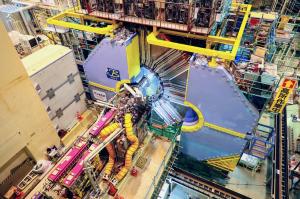UH physics team seeks new phenomena through Japan particle collider
University of Hawaiʻi at MānoaAssociate Professor, Physics and Astronomy
Thomas Browder, (808) 956-2936
Professor, Physics and Astronomy

SuperKEKB accelerator and Belle II detector in Tsukuba, Japan. Photo courtesy of Shota Takahashi of KEK
A University of Hawai‘i at Mānoa physics project, the Belle II experiment at the SuperKEKB particle accelerator in Japan, has passed a significant milestone. On March 11, SuperKEKB circulated an electron beam moving close to the speed of light through more than a thousand magnets in a narrow tube around the 3-kilometer circumference of its underground main ring. The BEAST Time Projection Chambers, detectors of elementary particles designed by UH physicists, observed these first turns. Days later, the positron beam has also circulated, and preparations are now being made for colliding the two beams together.
The Belle II experiment is an international collaboration hosted by KEK in Tsukuba, Japan. Using a state-of-the-art experimental apparatus, Belle II aims to seek out new physics hidden in subatomic particles that could shed light on mysteries of the early universe. The Belle II detector precisely measures elementary particle interactions created with the upgraded SuperKEKB accelerator.
Successfully circulating the electron beam marks the beginning of the phase three of the SuperKEKB project, Japan’s largest electron-positron collider, built 11 meters underground on the KEK Tsukuba campus. This phase will be the physics run of the project, in which the Belle II experiment will start taking data with a fully instrumented detector. The Belle II detector at SuperKEKB was designed and built by an international collaboration of more than 900 physicists and engineers from 26 countries.
The UH Mānoa team is led by physics professors Tom Browder, Kurtis Nishimura, Sven Vahsen and Gary Varner, along with UH Mānoa postdoctoral researchers and graduate students. They previously participated in the first Belle experiment at Tsukuba, Japan’s KEK B Factory.
In addition to the four UH Mānoa faculty members, members of the Belle II project are postdoctoral scholars Martin Bessner, Oskar Hartbrich, Shahab Kohani, Zachary Liptak, Richard Peschke, and Vasily Shebalin, engineer Matt Andrew, and graduate students Julien Cercillieux, Shawn Dubey, Christopher Ketter, Jeffrey Schueler and Boyang Zhang. Schueler and Liptak are currently in Japan, operating the BEAST II detector, Ketter is there operating the Belle II K-long and muon detector (KLM), while Bessner and Hartbrich are on site operating the time-of-propagation (TOP) counter.
The purpose of the upgraded Belle II experiment is to search for new physics phenomena that cannot be explained by the Standard Model of Particle Physics while making precision measurements of known phenomena. Electron-positron collisions produce large quantities of B meson pairs in a clean environment with no other accompanying particles. The decays of these B mesons can be studied to find deviations from the accepted theory. If statistically significant differences are found, this would be one of the first discoveries of new physics since the Standard Model was developed in the 1970s.
In order to confirm such a discovery, many more B pairs must be observed than have ever been produced in past electron-positron facilities. To make this possible, Belle II plans to become the world’s first super B factory, creating about 50 times the number of events of the original Belle experiment, which itself produced 760 million such events.
The KEKB accelerator, operated from 1999 to 2010, currently holds the world record for luminosity (number of collisions per second) in an electron-positron collider. SuperKEKB, its successor, plans to reach a luminosity 40 times greater over its lifetime.
